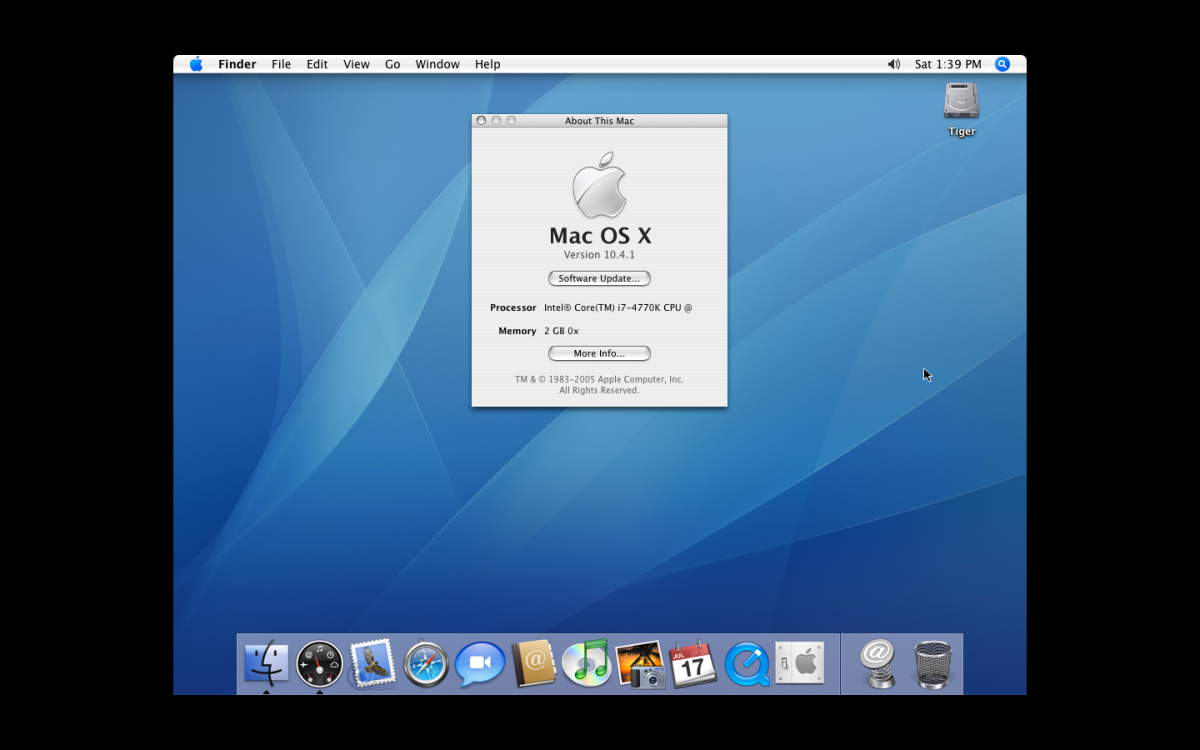


- VMWARE FOR MAC OS X 10.4.11 INSTALL
- VMWARE FOR MAC OS X 10.4.11 DRIVERS
- VMWARE FOR MAC OS X 10.4.11 SOFTWARE
You need to boot the server and install the client and the 10.4.11 update from the server boot. If you want to install a client it's complicated. It's worth pointing out that AHCI is supported from 10.4.11 and that the Server build from Apple's website is able to boot from any hardware and you should update from that one. After trimming them to the bare minimal it seems that cpuid(eax=2) is the one crashing the VM. I've tried reproducing all the cpuid flags from a core 2 duo cpu and saw that it works.
VMWARE FOR MAC OS X 10.4.11 DRIVERS
I've tried everything and only the EFI frame buffer drivers work. I personally have VMs of all client operating systems running without issues on VMWare Fusion 6.0.2 Post-install, you can also switch to SATA in VMWare Fusion, as long as you delete the kernel caches and let the boot loader rebuild them. My solution was to create a VM with two optical drives one with a 10.4.7 Server image and another one with an unlocked 10.4.5 Mac Mini image:ġ) Boot from the 10.4.7 Server VM which has a kernel that is able to boot on most modern CPUs (except Haswell in my experience, but I'm sure that we can also find a workaround for that).ģ) Start the previously hardware unlocked installer from the other virtual CDROM for OS X client 10.4.something.Ĥ) Once the installer finishes start (from an attached USB stick for example) the update to 10.4.11 (which also supports pre-haswell CPUs).įrom what I can tell, builds older than 10.4.7 do not work on modern CPUs My topic covers the solution of issue 2, as issue 1 and 3 the solutions are known and very widespread already.
VMWARE FOR MAC OS X 10.4.11 SOFTWARE
Issue 3 occurs after you were already inside the Installer application, interacting with buttons and dialogs, so it's a software restriction. Issue 2 is a hardware issue, that occurs when you just power on the machine, and it stops suddenly without finishing the boot sequence by having a more modern host CPU than the ones recognized by Tiger.

Issue 1 does not even allow you to power on the VM, it's a VMWare restriction, that is fixed by patching it with the "Guest Unlocker". I was already aware of issues 1 and 3, and already fixed both by using the "Guest Enabler" and modifying the Installer script before creating the ISO. The Installer script must be modified to allow it to install to any hardware non-PowerPC. When virtualizing Tiger, there are 3 problems you need to fix:ġ- Use the "Guest Unlocker" to allow Workstation to create and power on OSX VMs (in case of Fusion, it enables to power on client versions of OSX) Ģ- Tiger was designed for 1st generation Intel Core 2 processors, so it halts during boot if it does not recognize the host CPU (the error and solution I described in this topic) ģ- Tiger Install DVDs are locked to specific Apple machines (in my case a MacBookPro3,1), otherwise, during the Installer, you will get a warning that it cannot be installed in that machine, and install cannot proceed. Yes, I used the "Guest Unlocker", then configured a OSX 10.5 VM (32 bits). vmx file, your processor will fake reporting as being an "Intel Core 2 Duo T7700"ĭarkstar wrote:Did you try the MacOS X Unlocker? I think it should work as well (or does it only work for 10.5 upwards?) So, I would like to share the solution with you, who might get this issue too:īy adding the following line to your. It worked flawlessly, and blazing fast! I was able to install, and use Tiger normally, as all later versions of virtualized OSX! I followed this line of solution, and retrieved the information about my MacBookPro processor, and then added the CPUID information to the. vmx file, and faking the processor as reporting to be another one. The solution they found was to mask the CPUID as an earlier processor by adding a line to the. Upon investigating and searching, I found a topic in InsanelyMac about this error occurring when people tried to install SnowLeopard on modern CPUs as Core i7, as the OS does not recognize modern CPU it was not designed for. You will need to power off or reset the virtual machine at this point."Īltough I was able to virtualize all later OSX (from 10.5 to 10.9), no luck with Tiger. "The CPU has been disabled by the guest operating system. However, as soon as I powered on the virtual machine, at the grey Apple logo, I got a VMWare error: Sometime ago I tried to virtualize OSX Tiger 10.4.9 with install DVD from my MacBookPro 2007.


 0 kommentar(er)
0 kommentar(er)
